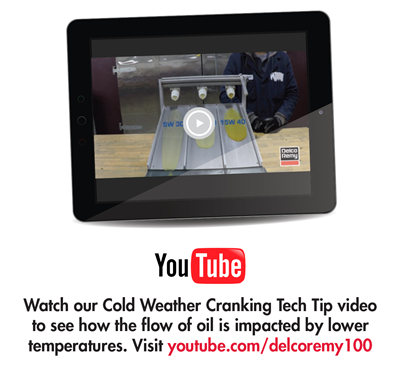
Winter months are upon us and with them come cold temperatures and “cold cranking.” There are three factors that primarily contribute to cranking issues:
- Oil viscosity
- State of starter main cables
- Batteries
Unfortunately, sometimes these factors—especially oil viscosity—are overlooked or even ignored. Read on to learn about each one and what you can do.
Oil Viscosity
Switching to a lower viscosity oil during the winter season offers these benefits:
- Easier engine start
- Faster engine lubrication
- Less energy consumption at engine start
The chart below shows crank speeds for a typical 15-liter engine with four 750 CCA batteries at -18˚C (0˚F) with decreasing oil viscosities. The use of lower viscosity oils provides significant improvements in crank speed. Lower viscosity oil equates to faster crank speeds, quicker starts and lower starter current draws.

Selection of oil viscosity should be in accordance with OEM guidelines. The following chart shows typical viscosity ranges versus temperature, but each OEM should be consulted for exact recommendations for a given engine application.
 Starter Main Cables
Starter Main Cables
The state of the starter main cables is another significant factor involved in reliable cold cranking. Before the winter months is the most idea time to check cables for loose connections and corrosion, both of which can increase circuit resistance and lead to slower cranking speeds. As a general rule of thumb, for every one-volt drop in the starter circuit, there will be a loss of approximately 28 RRM in cranking speed. The chart below shows the effect of increasing circuit resistance on cold crank speed.
 Batteries
Batteries
Most understand that healthy batteries are important for reliable cold cranking. Batteries with a low state of charge will not only cause a loss of cranking speed, but also a loss of available cranking time based on the diminished reserve capacity. This chart shows the effect of a decreasing battery charge on cranking speed.
